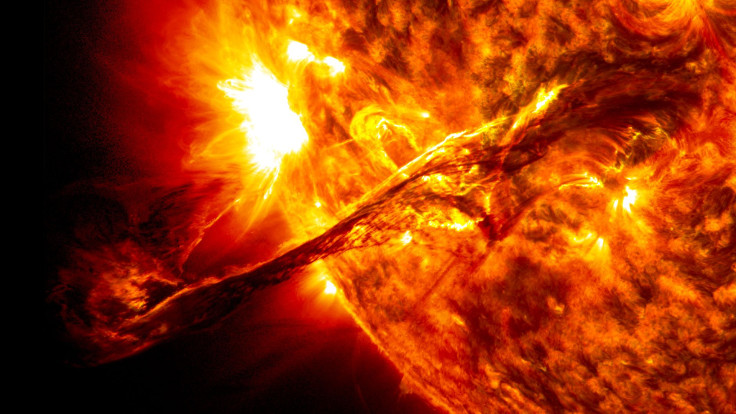Sun Eruptions Are All The Same: Solar Energy Erupts Through A Magnetic Field

The sun erupts in many different ways, but scientists have discovered all those eruptions follow a similar pattern involving magnetic fields and bursts of energy.
Researchers studied coronal mass ejections, which are enormous explosions from the sun of hot gas called plasma and electrically charged particles, and the smaller ejections of hot gas called coronal jets that are a major factor in the solar wind. A study in the journal Nature found they now understand both of those eruptive events occur — although on different scales — when cold and dense swaths of material called filaments bulge, break through the sun’s magnetic fields and explode into space.
Read: How the Sun Changes Earth’s Electricity
It breaks out by putting so much stress on the magnetic fields suppressing it that they “explosively realign into a new configuration,” NASA’s Goddard Space Flight Center said. When that happens, the energy in the filament can finally erupt out of the sun.
The researchers suggest that if both coronal mass ejections and coronal jets have the same source, this process can be considered “a universal model for solar eruptions.”
Previously, scientists said they had different underlying mechanisms because they had such different results.
“Our theoretical model shows the jet can essentially be described as a mini-[coronal mass ejection],” lead author Peter Wyper, a solar physicist at Durham University, said in the NASA statement. The university worked with the space agency on the project. “Now we have the possibility to explain a continuum of eruptions through the same process.”
But if they are driven by the same mechanism, why do they look so different? NASA explains the magnetic field around the filament can be different strengths and shapes, which would affect how the material erupts. For example, magnetic fields looping above a filament will produce a bubble-shaped explosion — a coronal mass ejection.
“The breakout model unifies our picture of what’s going on at the sun,” study co-author Richard DeVore, a solar physicist at Goddard, said. “Within a unified context, we can advance understanding of how these eruptions are started, how to predict them and how to better understand their consequences.”
What the sun does is important to us on Earth — solar eruptions can affect the magnetic fields around our planet, which in turn can disrupt our communications and navigation systems, and other technology that relay signals through the atmosphere. We can see this effect with our own eyes when charged particles blown here from the sun interact with gases in the atmosphere and magnetic fields around Earth to create swirling, colorful auroras.
See also:
© Copyright IBTimes 2024. All rights reserved.





















